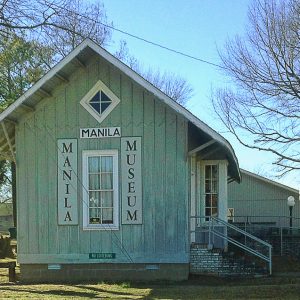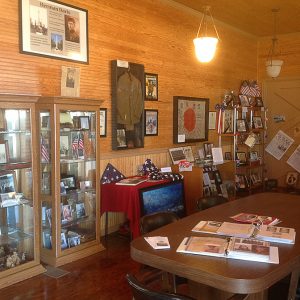calsfoundation@cals.org
Manila Depot Museum and Main Street Historical Museum
The Manila Depot Museum is housed in the old train depot located at the corner of Baltimore Avenue and North Dewey Street in Manila (Mississippi County). The depot was built around 1910 after the original depot was destroyed by fire following a lightning strike. The museum was established in 2001. In 2014, it expanded into another building, which became known as the Main Street Historical Museum. The mission of both museums is to preserve, display, maintain, and interpret Manila’s rich heritage through artifacts, photos, newspapers, personal mementos, and oral histories. The museum seeks to promote education and awareness of the extensive diversity of the area by preserving and promoting collections that reflect the history of the people of Manila.
The first train of the Jonesboro, Lake City and Eastern Railroad (JLC&E) arrived in Manila on December 2, 1900. In 1911, planter Robert E. Lee Wilson purchased the railroad. He sold it to the St. Louis–San Francisco Railway in 1925. Train service ended at the depot on December 30, 1977. The building was used as a meeting place for the Manila chapters of the Professional Business Women’s Club and the Mississippi County Home Extension Club. Both clubs held fundraisers and accepted donations to repair the dilapidated building. The building was completely restored in 1997 with funds from the estates of Eena Wilson Grieshammer and her sister, Roxie Wilson Cates.
The depot was listed on the National Register of Historic Places on February 8, 1997, as an amendment to the “Historic Railroad Depots of Arkansas.” It is the best example of a traditional board-and-batten railroad depot in northern Mississippi County. The museum opened in 2001 in the depot, and the exhibits have expanded each year with the acquisition of various items donated by local residents. The depot’s western end, the original loading dock and storage area, is dedicated to materials from veterans from Manila and surrounding areas. Exhibits include displays from World War I, World War II, the Korean War, the Vietnam War, Operation Desert Storm, and Operation Iraqi Freedom. The remaining rooms, the depot office and waiting room, re-create how the depot looked in its heyday, 1910–1925. Many original items were recovered from residents, including a telegraph, desk and chair, and ticket cabinet. A pot-bellied stove is located in the office/waiting room.
In 2014, the Depot Committee, which oversees the museum, partnered with the City of Manila and the Manila Industrial Commission to purchase a building on Baltimore Avenue (Main Street) to expand the museum. The Main Street Historical Museum houses exhibits and artifacts that depict everyday life in Manila during its early years. Exhibits include sections dedicated to the New Madrid Earthquake and the Big Lake National Wildlife Refuge; a mercantile/dry goods store; a tack/tool shop; and a 1930s-era kitchen, bedroom, and laundry area. The largest exhibit is dedicated to the cotton industry that shaped the economy of the area for decades.
The museums are open on Saturdays from 12:00 p.m. to 2:00 p.m. or by appointment.
For additional information:
Dew, Lee A. The JLC&E: The History of an Arkansas Railroad. Jonesboro: Arkansas State University Press, 1968.
Jackson, Donna Brewer. “Manila: 1901–2001: A Centennial Celebration.” Jonesboro: Master Printing, 2001.
“Jonesboro, Lake City & Eastern Railroad Depot.” National Register of Historic Places registration form. On file at Arkansas Historic Preservation Program, Little Rock, Arkansas. Online at http://www.arkansaspreservation.com/National-Register-Listings/PDF/MS0108.nr.pdf (accessed January 29, 2018).
“Train Service Comes to Buffalo Island in 1898.” Bicentennial Edition. Northeast Arkansas Town Crier, June 17, 1976.
Donna Brewer Jackson
Manila, Arkansas
 Historic Preservation
Historic Preservation Museums
Museums Manila Depot Museum and Main Street Historical Museum
Manila Depot Museum and Main Street Historical Museum  Manila Depot Museum Interior
Manila Depot Museum Interior 



Comments
No comments on this entry yet.